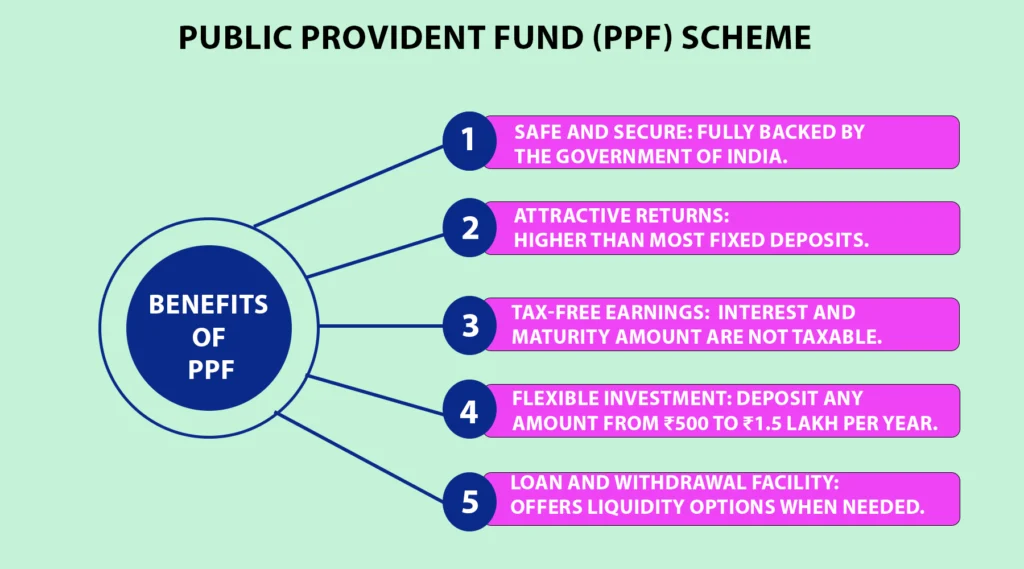Last updated on October 17th, 2025 at 05:22 pm
Public Provident Fund (PPF) is a Savings Scheme provided by Government of India sponsored savings scheme aimed to provide Long Term savings scheme with a stable return. It aims to encourage small savings while providing a safe and tax-efficient avenue for building corpus for future. The scheme combines the benefits of attractive interest rates, tax savings, and guaranteed returns backed by the government.
What is the Public Provident Fund?
The Public Provident Fund (PPF) is a government-backed savings scheme that allows individuals to invest regularly and earn interest over a fixed tenure of 15 years. It is regulated by the Public Provident Fund Act, 1968 and is managed by the Ministry of Finance.
You can open a PPF account with any authorized bank or post office, and it can be easily accessed online in most banks today.
Key Features of the PPF Scheme
| Feature | Details |
|---|---|
| Eligibility | Any Indian citizen can open a PPF account. NRIs and HUFs are not eligible. |
| Minimum Investment | ₹500 per financial year |
| Maximum Investment | ₹1.5 lakh per financial year |
| Tenure | 15 years (extendable in blocks of 5 years) |
| Interest Rate | Decided quarterly by the Government of India (currently 7.1% p.a.) |
| Compounding | Interest is compounded annually |
| Deposit Mode | Lump-sum or in a maximum of 12 installments per year |
| Nomination Facility | Available |
| Loan Facility | Loan can be taken between 3rd and 6th year of account opening |
| Partial Withdrawal | Allowed from the 7th financial year onwards |
| Extension Option | Account can be extended after 15 years for additional 5-year blocks with or without fresh deposits |

PPF Account Rules You Must Know
- Single Account Rule – Only one PPF account can be held per individual.
- Joint Accounts Not Allowed – PPF is only for individuals; no joint ownership is permitted.
- Deposit Limit – Depositing more than ₹1.5 lakh in a financial year does not earn interest and is not eligible for tax deduction.
- Lock-in Period – The PPF has a 15-year lock-in period.
- Account Transfer – You can transfer your PPF account between banks or post offices anywhere in India.
- Premature Closure – Allowed after 5 years only under specific conditions like serious illness or higher education needs, subject to a 1% reduction in interest rate.
Tax Benefits under PPF
The PPF enjoys “Exempt-Exempt-Exempt (EEE)” status under the Income Tax Act, 1961 — making it one of the most tax-efficient investments in India.
- Tax Deduction (Section 80C):
Deposits up to ₹1.5 lakh per financial year qualify for deduction under Section 80C. - Tax-Free Interest:
The interest earned on PPF is completely exempt from tax. - Tax-Free Maturity Amount:
The total maturity amount received at the end of the 15-year term is fully tax-free.
Benefits of Investing in PPF
- Safe and Secure: Fully backed by the Government of India.
- Attractive Returns: Higher than most fixed deposits.
- Tax-Free Earnings: Interest and maturity amount are not taxable.
- Flexible Investment: Deposit any amount from ₹500 to ₹1.5 lakh per year.
- Loan and Withdrawal Facility: Offers liquidity options when needed.
- Retirement Planning: Ideal for building a long-term corpus with guaranteed returns.
How to Open a Public Provident Fund Account
You can open a PPF account in two ways:
- Offline: Visit any post office or designated bank branch with KYC documents, passport-size photos, and initial deposit.
- Online: Most major banks offer PPF account opening through net banking or mobile apps.
Conclusion
The Public Provident Fund (PPF) is an ideal investment option for individuals seeking safe, long-term, and tax-free returns. With its government guarantee, flexible deposit structure, and EEE tax benefit, it is one of the best tools for retirement planning and financial stability.
If you’re looking for a secure savings avenue with guaranteed growth, opening a PPF account is a smart financial move.